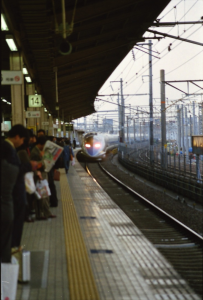Nagoya, 2:30pm – not like a Swiss Watch
Nagoya is a city two thirds of the way to Osaka, 366km (101 minutes) out of Tokyo by Shinkansen. We visited Yoko’s cousin there for lunch one day in 2000. Standing on the platform waiting for our train back to Tokyo, we noticed a curious thing.
A Nozomi (premium express) train stopped and left. Then, almost straight away the stopping all stations Kodama stopped and followed it out. We didn’t catch either of these because the stopper would be too slow and the “premium” too much, so we were still there 2 minutes later when another Nozomi (premium express) pulled in. Off it went following the other two, still disappearing in the distance as our express train (A Hikari running express apart from just a couple of stations – one we could catch with our Japan Rail pass) arrived and we got on.
It is an interesting fact about this 270km/hr Shinkansen line that it comprises just a single up track and a single down track (with loops to the side at each station) for its entire length. What we had just seen were four trains, a mixture of stopping and express trains, run through Nagoya at 2 minute timetabled headway. At Tokyo we knew those trains would arrive, sorted out, at their normal orderly 7 – 8 minute intervals, get cleaned and leave. We’d seen it.
How could they do all that with just two tracks and a couple of station loops?
When I returned to Australia, I checked the timetable. It turns out the what we saw was no sequence of disrupted trains trying to recover; these “4 trains in 7 minutes” (2 minute TT spacing) can be seen around half passed the hour, every hour, every day of the year at Nagoya.
And that is not all they do.
At Toyohashi, 72 km down the line, the stopper waits a few minutes at the station to be passed by our express train and the first Nozomi. Then at Kakegawa (137 km down the line) our train waits to be passed by a Nozomi, then again by a second Nozomi at Mishima.
On arrival at Tokyo, we saw the staff waiting as we got off so that the orderly 5 minutes of cleaning and turnaround could occur.
Here in Melbourne, received wisdom is that our “signalled for ultimate capacity” underground loop cannot support operational reliability (meaning 85% of services within 3 minutes of timetable) at timetabled intervals better than 3 minutes (22 trains in an hour at a pinch) stopping trains at 60km/hr even running sausage machine style. Here at Nagoya we saw 2 minute intervals with mixed stopping patterns.
So how does JR Central go running its 270km/hr service through Nagoya at 2 minute timetable intervals? Average “late running to schedule” is less than 30 seconds and more than 85% are within 1 minute. The comment made was that these figures would be better if it were not for the need to shut the network down (precautionary measure) due to earthquakes on a weekly (roughly) basis.
“They sacrifice safety in their culture of running on time at all costs”, my Australian colleagues informed me. I could not help noticing at the Shinkansen 50th anniversary celebrations in 2014 that passenger deaths and collisions for the network stood at zero for the life of the network. Amongst the “safety incident” posters at JR East’s office it was noted that some birds had died due to collisions with train and overhead. There had also been a single derailment causing minor injuries during the earthquake in 2011.
Perhaps they would be happy to swap their culture for our “safety culture” where, measured across decades, head to tail collisions are a regular occurrence. It would be difficult to recommend that swap to them.
The JR (*) culture is not just one of very high operational reliability, it is also one of very high technical reliability. Having systems that fail safe – that is one thing. Having systems that almost never fail at all – that is something else again.
The Swiss Railways are also renowned for their high reliability. The resemblance to a Swiss watch can be seen in their extensively interlocked network of intercity hubs. The trains all arrive at once at each hub on the half hour; the passengers all interchange to their next service, then all the trains leave to do it all again when they arrive at their next hub. This is also very impressive and based on a similar culture of reliability.
The Swiss are much too sensible to try to run the local lines and the high speed through lines mixed up together as a single line pair though. This is an achievement found no better than in Japan, half past each hour, at Nagoya.
- Categories
- Public Transport


